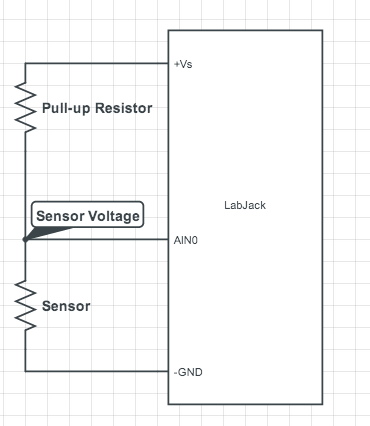Typical Analog Sensors (App Note)
The signal wire on most analog sensors will be connected as 'single-ended'. In general, single-ended means that the sensor will have a power and ground wire that connect to VS and GND on the LabJack, and then a signal wire will connect to a single AIN terminal (single-ended analog input). Example sensors that fit this category are:
Analog Hall Effect Sensors
Analog Temperature & Humidity Sensors
Analog Gyros & Accelerometer's (That accept 5V input, 3.3V chip's will require additional circuitry or may be powered using a DAC output, keep in mind any current requirements DAC output current spec's are available in our device's Appendix A Users Guide section or the relevent datasheet)
Simple Resistive Sensors: Example
Most photocell, flex, force, and other resistive sensors can be connected to a LabJack with fairly simple circuitry concepts. They are simply sensors that change in resistance as something changes. The easiest way to connect one of these sensors is to create a voltage divider circuit and use the sensor as one of the resistor's. Your circuit will look like the following:

Simple Voltage Divider Circuit
In this setup the sensor voltage range will depend both on the Pull-up resistor and the sensor's current resistance. In general, it is best to choose a pull-up resistor of approximately equal resistance to your sensor. Once your sensor is connected you can use a simple voltage divider equation to calculate the sensor's resistance once you have the voltage reading on AIN0:

Voltage Divider Equations
Once you have the resistance value of the sensor you can use the sensor's datasheet to reach the appropriate units.
Analog Special Features, Differential Signals
This variation is sometimes called a 4-wire sensor where there are two signal wires (positive and negative) rather than one. If the negative signal is the same as power or ground it can be shorted to the appropriate terminal and the signal wire can be connected to a single AINx and a single-ended measurement can be made. Some sensors, that you can't simply capture a single-ended measurement from are bridge type sensors that provide the raw bridge output with a non-isolated excitation voltage. In this case, the signal voltage is the difference between the positive and negative signal, and the negative signal cannot be shorted to ground. In these applications an instrumentation amplifier is required to convert the differential signal to a single-ended, along with amplifying the signal. Some of our LabJack devices have special features that simplify some of the signal conditioning required before a reading can be acquired. Using the devices built in differential inputs and gain settings may be useful for reducing noise created by low-power sensors. This comes in handy for:
